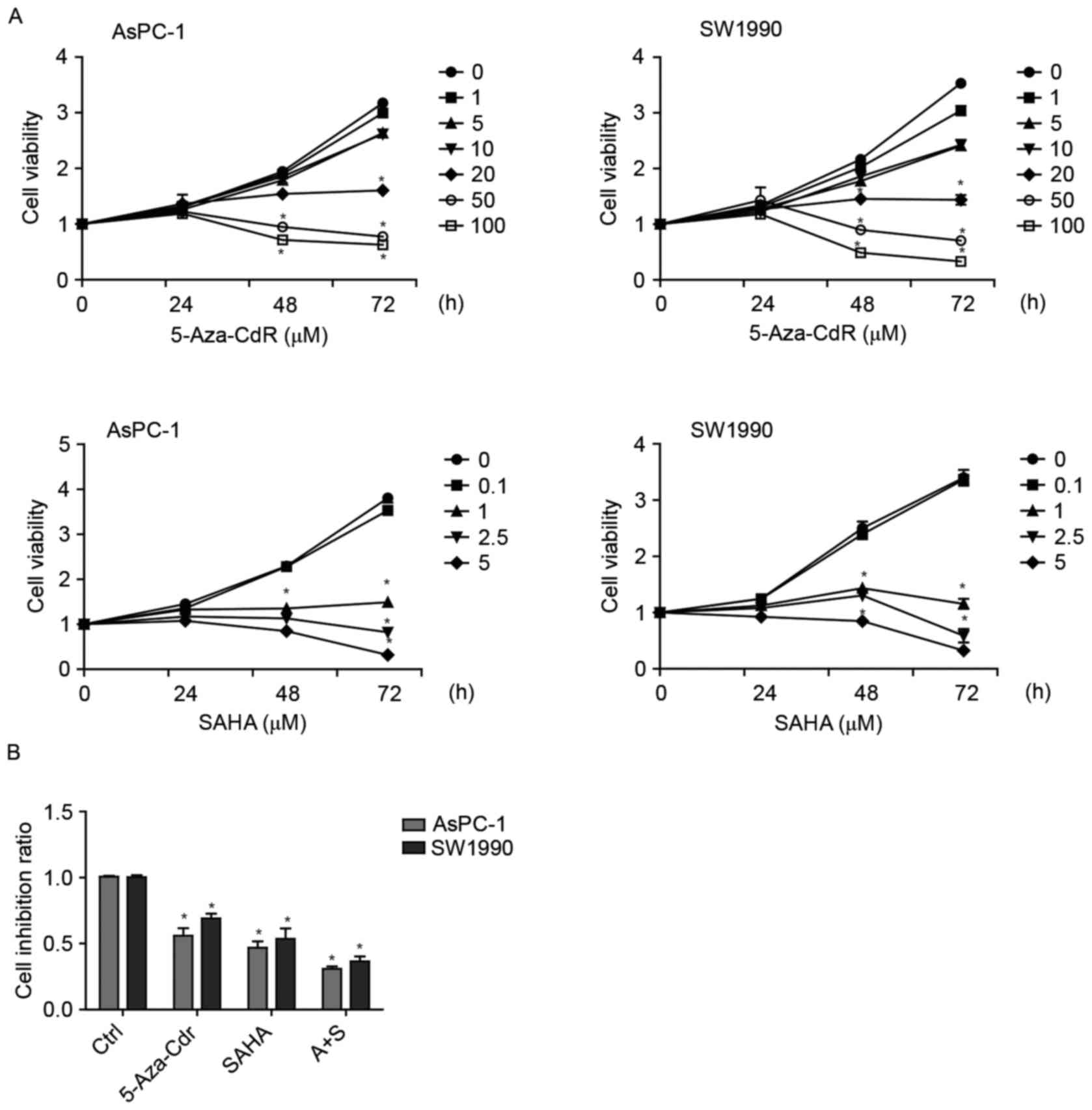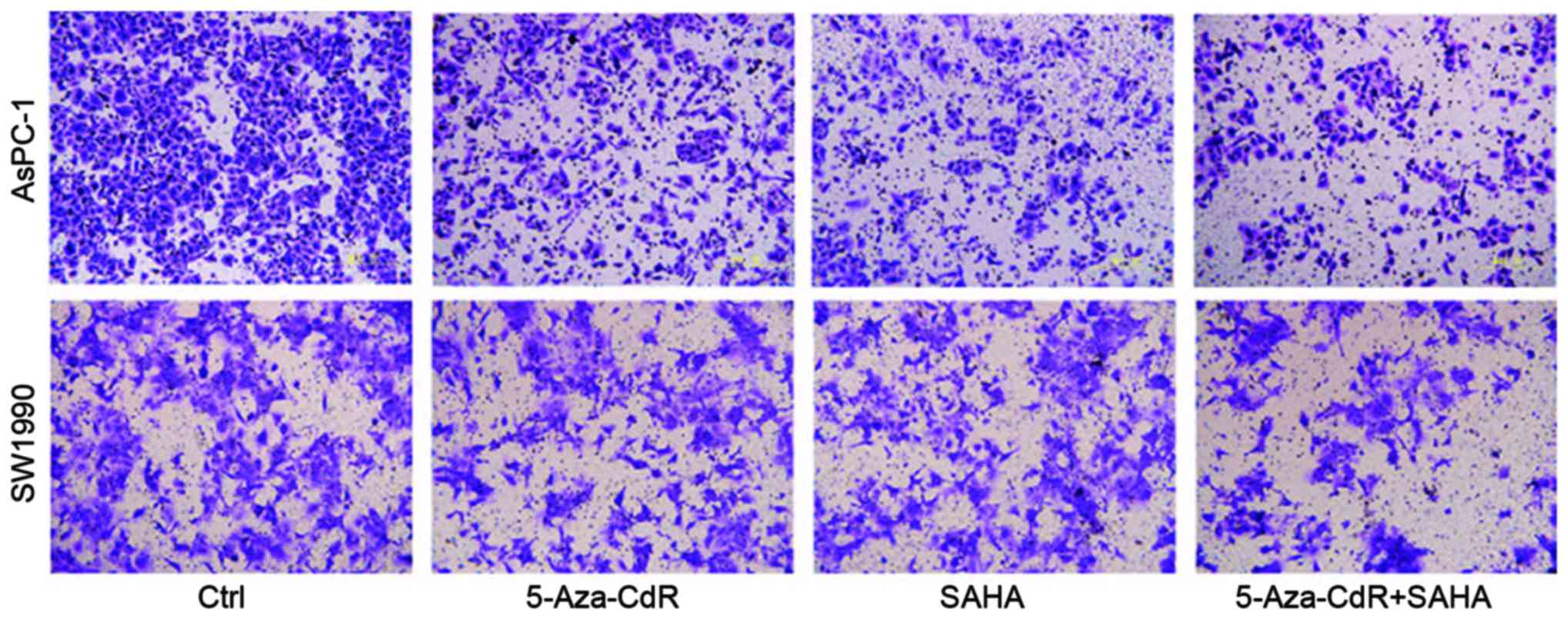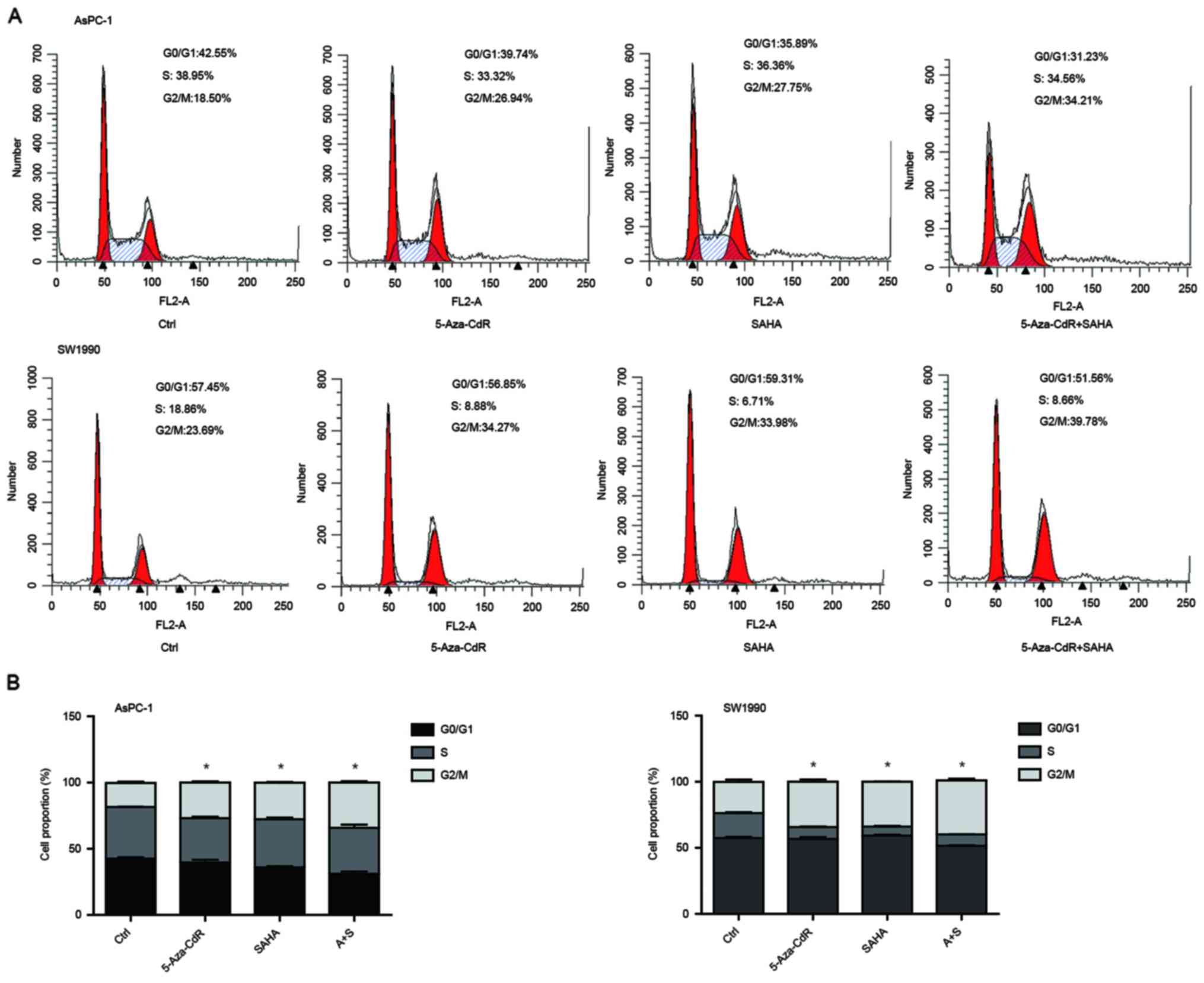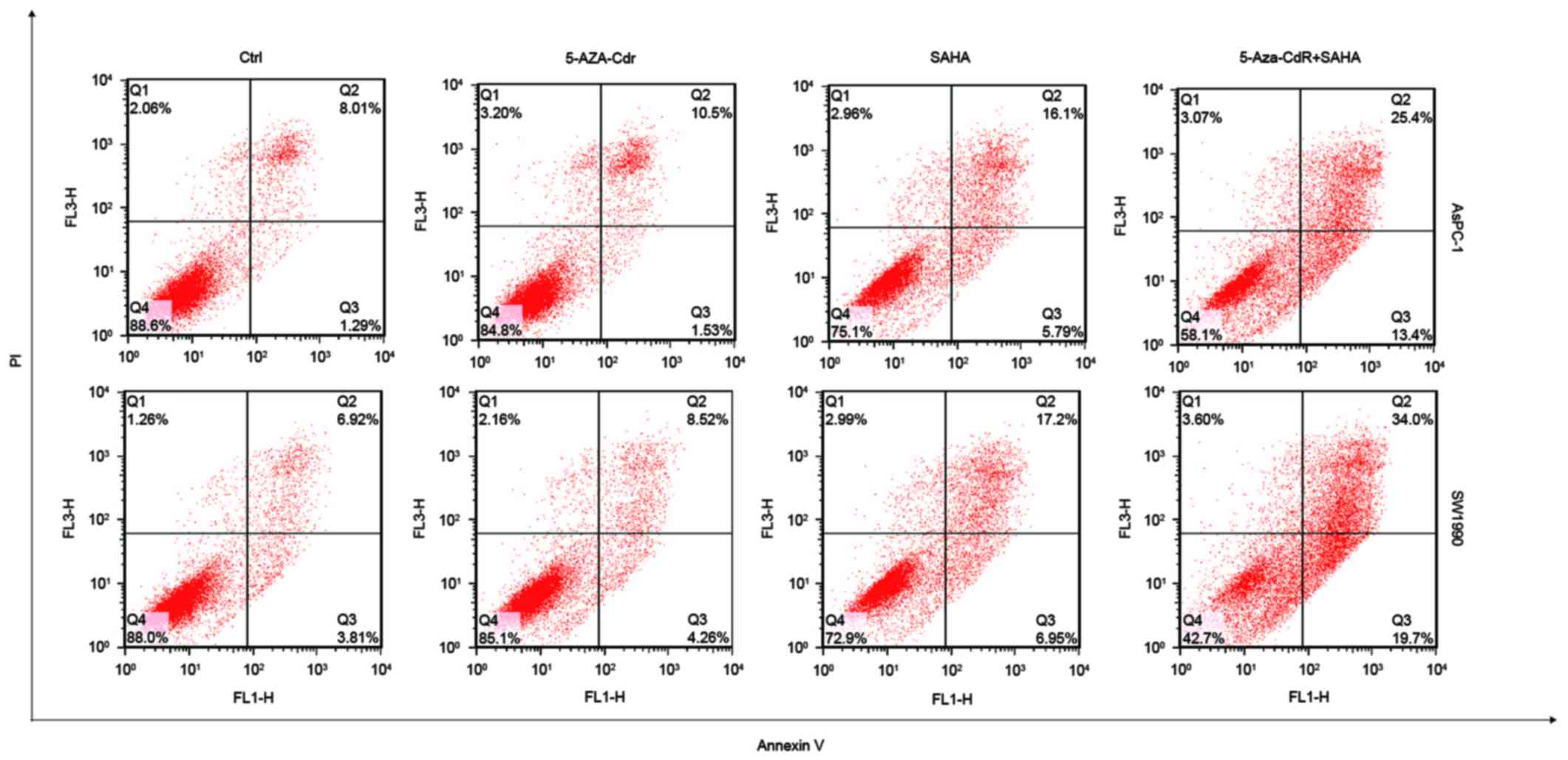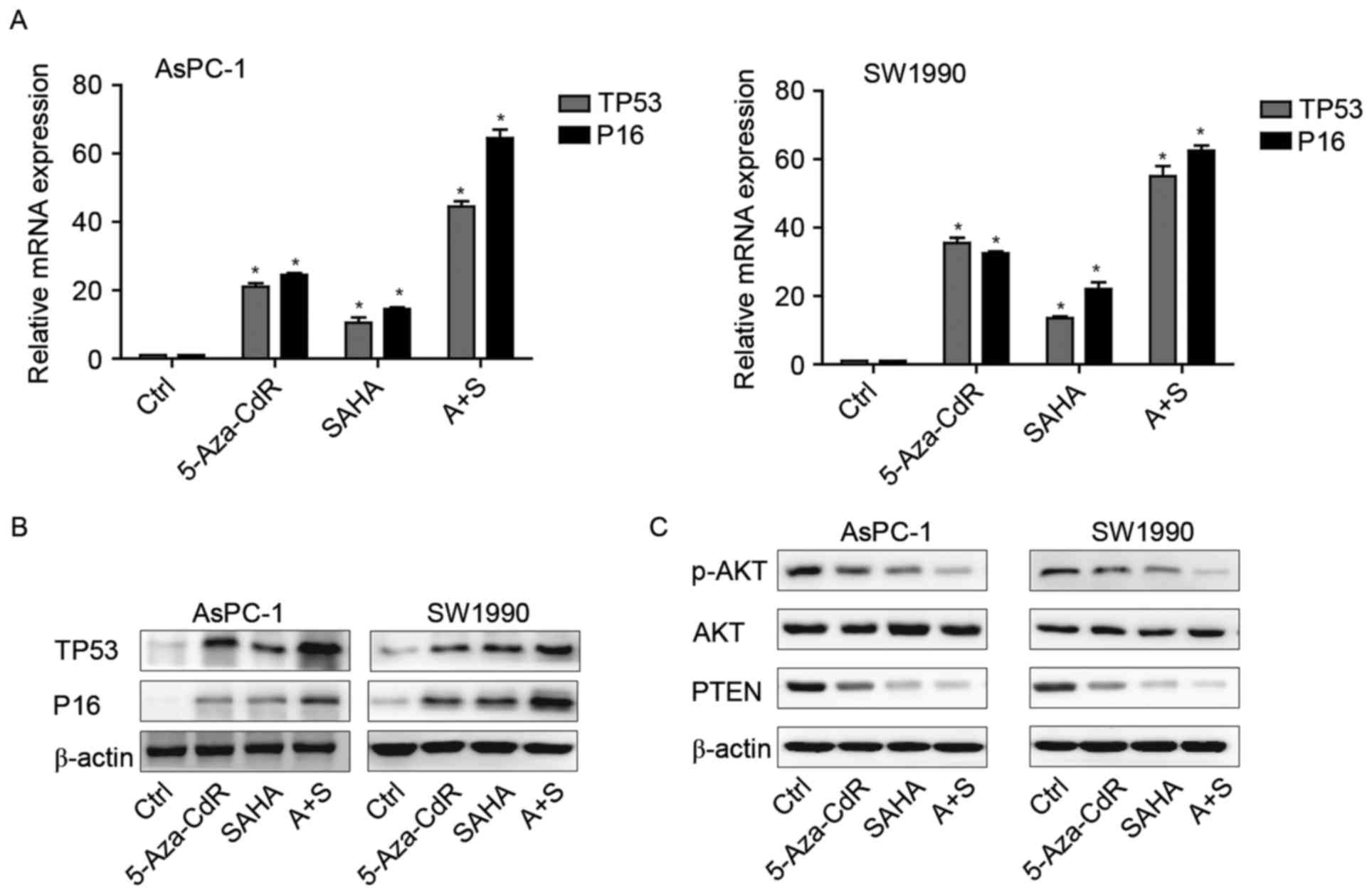Synergistic effects of the combination of 5-Aza‑CdR and suberoylanilide hydroxamic acid on the anticancer property of pancreatic cancer
- Authors:
- Published online on: October 31, 2017 https://doi.org/10.3892/or.2017.6059
- Pages: 264-270
Abstract
Introduction
Pancreatic cancer is a lethal disease. It is the fourth most common cause of cancer-related death in USA with a 5-year survival rate of <5% (1). This extremely malignant tumor type exhibits rapid progression without the presentation of obvious symptoms, and as a consequence it is advanced in the majority of cases at diagnosis (2,3). At that time, surgical intervention was not suitable for 80% of the patients (4,5). Current chemo- and radio-therapy have also met with limited success. Novel diagnostic and therapeutic strategies are urgently needed to improve prognosis for pancreatic cancer patients.
Epigenetic therapeutic agents, such as pan-HDAC inhibitors and DNA methyltransferase (DNMTs) inhibitors, have showed efficacy in the treatment of cutaneous T-cell lymphoma (CTCL) (6), myelodysplastic syndrome (MDS) (7,8), breast cancers (9), ovarian cancers (10). 5-Aza-CdR is currently one of the most commonly used demethylation nucleoside analogues (11). It mainly inhibits DNMT expression under a low concentration. It was approved by the Food and Drug Administration (FDA) to be mainly used for the treatment of blood system tumors. Suberoylanilide hydroxamic acid (SAHA) is an HDAC inhibitor that has the permeability to cross the blood-brain-barrier and to cause biological responses in the mouse brain, therefore, making it as a preferred candidate drug for testing in gliomas (12).
Comprehensive treatment is the main trend for cancers. Drug combinations are currently an important strategy for antitumor treatment. The aim of this study was to investigate the demethylation efficacy of 5-Aza-CdR in combination with SAHA on pancreatic cancer cells. It was demonstrated that 5-Aza-CdR combined with SAHA inhibited cell proliferation, migration and invasion, and induced cell cycle arrest and apoptosis, through upregulation tumor suppressor genes p16 and p53 and inhibiting PI3K/AKT/PTEN signaling pathway. This finding might provide a new strategy for the clinical treatment of pancreatic cancer.
Materials and methods
Cell lines and reagents
Pancreatic cancer cells lines AsPC-1 and SW1990 were all obtained from the Chinese Academy of Sciences Cell Bank (Shanghai, China). AsPC-1 were cultured in RPMI-1640 (Gibco) supplemented with 10% FBS, grown in 5% CO2 saturated humidity at 37°C. SW1990 cells were cultured in L-15 medium (Gibco) supplemented with 10% FBS.
5-Aza-CdR and SAHA were purchased from Sigma (Selleck). RPMI-1640 and Dulbecco's modified Eagle's medium were obtained from Invitrogen (Carlsbad, CA, USA). The Annexin/PI apoptosis analysis kit was from BD Biosciences (San Diego, CA, USA). Total RNA was isolated from the cultured cells by using miniBEST universal RNA extraction kit and amplificated using SYBR green RT-PCR mix (Takara Bio, Inc.).
Cell proliferation assay
SRB method was used to test cell proliferation with the treatment of 5-Aza-CdR and SAHA. Cells were seeded in 96-well microtiter tissue culture plates and cultured for 24 h. Then we added indicated concentration of 5-Aza-CdR and SAHA and cultured for 24, 48 and 72 h, respectively. At the end of the treatment, cells were fixed with 10% w/v of trichloroacetic acid (100 µl) for 1 h at 4°C. The plates were then washed and air-dried. Samples were stained with 100 µl of SRB solution (in 0.4% w/v in acetic acid) for 20 min at room temperature. The plates were then washed with acetic acid (1%) and air-dried. Tris-base (10 mM, 100 µl, pH 10.0) was added to each well for solubilization. Optical density (OD) values were measured at 540 nm with a reference wavelength of 630 nm using microtiter plate reader (VERSMax).
Cell migration and cell invasion assay
The cell migratory potential was evaluated using Transwell assay. Briefly, Transwell assay was conducted using specialized MilliCell chambers (Millipore, Bedford, MA, USA). The inserts contained an 8-µm pore size polycarbonate membrane. FBS-containing medium (10%) was placed in the lower chambers to act as a chemo-attractant. Then, 1×105 AsPC-1, SW1990 harvested from treatment group in a 100-µl volume of serum-free medium were placed in the upper chambers and incubated at 37°C for <24 h. Then they were fixed and stained by 0.1% crystal violet staining solution for 15 min. Cells on the upper surface of membrane were scraped off with cotton swabs and counted under a microscope in five randomly selected fields at a magnification of ×200 after dried.
Flow cytometry analysis of cell cycle and apoptosis
For cell apoptosis analysis, cells treated with single or two reagents were harvested at 70–80% confluence and incubated with reagent containing Annexin V-FITC and propidium iodide (BD Biosciences) for 15 min in darkness at room temperature. Apoptotic cells were analyzed using FACSCaliber flow cytometer (BD Biosciences).
Western blot analysis
The cells were treated with 5-Aza-CdR and SAHA, either alone or in combination for 72 h. The control cells were treated with 0.1% DMSO only. Total proteins were extracted from the cells using precooling lysis buffer, and the liquid was collected. After centrifugation at 120,000 × g for 5 min at 4°C, the supernatant was collected and the protein concentration was determined using the BCA protein assay kit according to the manufacturer's instructions. The protein lysates (20 µg/lane) were separated on 10% SDS polyacrylamide gel and transferred onto a nitrocellulose membrane. Each membrane was blocked with 5% BSA and then incubated with the indicated primary antibodies against P16, TP53, p-AKT, AKT, PTEN and β-actin overnight at 4°C. Subsequently, the membrane was incubated with the secondary antibodies for 1 h at room temperature.
Statistical analysis
The results were repeated in at least three separate experiments. The data are expressed as the means ± SD. Statistical comparisons were carried out using one-way analysis of variance, which revealed significant differences between groups. Statistical analyses were carried out using SPSS version 17.0 software (SPSS, Inc., Chicago, IL, USA). P<0.05 was considered to indicate a statistically significant difference.
Results
5-Aza-CdR and SAHA inhibits cell proliferation
To investigate the effect of 5-Aza-CdR and SAHA on cell growth, AsPC-1 and SW1990 cells were cultured with 5-Aza-CdR or/and SAHA for 24, 48 and 72 h. According to SRB assay, 5-Aza-CdR and SAHA reduced proliferation of the pancreatic cell lines in either time- or dose-dependent manner (Fig. 1A). Additionally, there was an enhanced additive effect of 5-Aza-CdR and SAHA on the proliferative inhibition of pancreatic cancer cells (Fig. 1B).
5-Aza-CdR and SAHA inhibit cell migration
We used a Transwell assay to examine the effects of 5-Aza-CdR and SAHA on pancreatic cancer cell migration. The number of 5-Aza-CdR or SAHA treated cells were remarkably reduced as compared to control group, indicating decreased migratory abilities following the treatment. The combination of both reagents inhibited cell migrated ablity the most (Fig. 2).
5-Aza-CdR and SAHA induce cell arrest and promote cell apoptosis
We performed flow cytometric analysis to assess whether cell cycle and apoptosis were altered. We observed that the cells were arrested in G2/M phase with the treatment of both 5-Aza-CdR and SAHA, and combination of two reagents induced more cells in G2 arrest (Fig. 3A). The proportion ratio of each period is also shown (Fig. 3B). SAHA alone induced cell apoptosis, but 5-Aza-CdR alone could not. Interestingly, combination of 5-Aza-CdR and SAHA remarkably increased apoptosis (Fig. 4).
The mRNA and protein expression of p16, p53 and Rb in pancreatic cancer cells after the exposure to 5-Aza-CdR or/and SAHA
In order to demonstrate whether 5-Aza-CdR and SAHA have an effect at the transcriptional and protein level, PCR and WB was used to detect the levels of tumor-suppressor genes P16 and TP53. After the treatment with 5-Aza-CdR or/and SAHA, the mRNA and protein expression levels of P16 and TP53 were upregulated in treated groups compared to those observed in the control. Their combination was more significantly enhanced when compared with the levels following treatment with 5-Aza-CdR or SAHA alone (Fig. 5A and B).
5-Aza-CdR or/and SAHA inhibit the PI3K/AKT/PTEN signaling pathway
PI3K/AKT signaling pathway has been reported to be activated in pancreatic cancer (13). Here, we investigated whether these two agents could affect this pathways, leading to pancreatic cancer cell inhibition. Our findings showed that either alone or combined, they could downregulate p-AKT and PTEN expression in both cell types (Fig. 5C).
Discussion
Pancreatic cancer is a world-wide problem that is hard to conquer. This is because its unique anatomic location and rapid progress. Gemcitabine has been the standard systemic therapy for the palliative treatment of pancreatic cancer over the last decade, although the 1-year survival rate of <20% remains unsatisfactory (14–17). Many studies have shown epigenetic modifications associated with cancer (18,19). Epigenetic modification has been shown as promising antitumor effect in T cell lymphoma (20), acute myeloid leukemia (21,22), breast cancers (9), and some other malignant tumors (23), however, with limited efficacy of limited drugs. Therefore, novel therapies are urgently needed to better inhibit pancreatic cancer cell proliferation and prolong overall survival time of the patients. At these circumstances, we consider that some epigenetic inhibitors might take effect since epigenetic modification is involved in the pancreatic cancer progression (24). Here, we reported two drugs, 5-Aza-CdR and SAHA, and aimed to define their combination effects on pancreatic cancer cells.
5-Aza-CdR was first characterized 30 years ago and it functions as a mechanism-dependent suicide inhibitor of DNA methyltransferases, with which genes silenced by hypermethylation can be reactivated (25). SAHA is a pan-HDAC inhibitor, and the antitumor effects of SAHA have been reported in chronic myelogenous leukemia (26), lung (27), pancreatic (28), liver (29), cervical (30), head and neck (31), breast (32) and ovarian cancers (33). Our results showed that 5-Aza-CdR or SAHA could inhibit pancreatic cancer cell proliferation in a dose- and time-dependent manner. Then we further investigated the possible mechanism of its inhibition. We detected cell migration, invasion, the cell cycle and apoptosis. We found that 5-Aza-CdR or SAHA alone could decrease the migration of pancreatic cancer cells and induced cell cycle arrest. SAHA increased cell apoptosis, however, 5-Aza-CdR could not induce cell apoptosis. Combination of two drugs had stronger inhibition effect than each one alone. Specially, combination of 5-Aza-CdR and SAHA enhanced apoptosis, though 5-Aza-CdR had no effects alone. TP53 has been reported with high methylation and promoter in different cancers, such as mutiple myeloma (34), esophageal squamous cell cancer (35), lung cancer (36), and breast cancer (37). The gene encoding p16 is mutated or downregulated in several cancer cells (38–40). However, breast carcinoma progression has been related to overexpression of p16 (41), and this has been reported in head and neck squamous carcinoma (42), in prostate carcinoma (43). Here, we detected TP53 and p16 mRNA and protein expression after treatment of 5-Aza-CdR and SAHA. We found both expressions were upregulated after treatment. Besides, the two drugs inhibited the PI3K/AKT/PTEN signaling pathway, leading to inhibition of cell proliferation.
In conclusion, this study illustrated that treatment with epigenetic agents decreased cell proliferation and induced cell death in pancreatic cancer cells, while we also demonstrated that epigenetic agents were able to upregulate TP53, P16 expression and inhibited the I3K/AKT/PTEN signaling pathway. These data suggest that epigenetic therapy has the potential to delay pancreatic progression, and may have potential application in the management of pancreatic cancer.
Acknowledgements
This study was supported by the National Natural Science Foundation of China (grant nos. 81502017, 81502018, 81572315, 81171887 and 91229117), and in part by National Key Clinical Discipline-Oncology.
References
|
Siegel RL, Miller KD and Jemal A: Cancer statistics, 2015. CA Cancer J Clin. 65:5–29. 2015. View Article : Google Scholar : PubMed/NCBI | |
|
American Cancer Society, . Cancer Facts and Figures 2008. American Cancer Society; Atlanta, GA: 2008, https://www.cancer.org/research/cancer-facts-statistics/all-cancer-facts-figures/cancer-facts-figures-2008.html | |
|
American Cancer Society, . Cancer Facts and Figures 2007. American Cancer Society; Atlanta, GA: 2007, https://www.cancer.org/research/cancer-facts-statistics/all-cancer-facts-figures/cancer-facts-figures-2007.html | |
|
Von Hoff DD, Evans DB and Hruban RH: Pancreatic Cancer. 1st. Jones and Bartlett Publishers; Sudbury, MA: 2005 | |
|
Chang DK, Merrett ND and Biankin AV; NSW Pancreatic Cancer Network, : Improving outcomes for operable pancreatic cancer: Is access to safer surgery the problem? J Gastroenterol Hepatol. 23:1036–1045. 2008. View Article : Google Scholar : PubMed/NCBI | |
|
Glaser KB: HDAC inhibitors: Clinical update and mechanism-based potential. Biochem Pharmacol. 74:659–671. 2007. View Article : Google Scholar : PubMed/NCBI | |
|
Gore SD: Combination therapy with DNA methyltransferase inhibitors in hematologic malignancies. Nat Clin Pract Oncol. 2 Suppl 1:S30–S35. 2005. View Article : Google Scholar : PubMed/NCBI | |
|
Issa JP and Byrd JC: Decitabine in chronic leukemias. Semin Hematol. 42 Suppl 2:S43–S49. 2005. View Article : Google Scholar : PubMed/NCBI | |
|
Munster PN, Troso-Sandoval T, Rosen N, Rifkind R, Marks PA and Richon VM: The histone deacetylase inhibitor suberoylanilide hydroxamic acid induces differentiation of human breast cancer cells. Cancer Res. 61:8492–8497. 2001.PubMed/NCBI | |
|
Yang XF, Zhao ZJ, Liu JJ, Yang XH, Gao Y, Zhao S, Shi S, Huang KQ and Zheng HC: SAHA and/or MG132 reverse the aggressive phenotypes of glioma cells: An in vitro and vivo study. Oncotarget. 8:3156–3169. 2017.PubMed/NCBI | |
|
Brueckner B, Kuck D and Lyko F: DNA methyltransferase inhibitors for cancer therapy. Cancer J. 13:17–22. 2007. View Article : Google Scholar : PubMed/NCBI | |
|
Hockly E, Richon VM, Woodman B, Smith DL, Zhou X, Rosa E, Sathasivam K, Ghazi-Noori S, Mahal A, Lowden PA, et al: Suberoylanilide hydroxamic acid, a histone deacetylase inhibitor, ameliorates motor deficits in a mouse model of Huntington's disease. Proc Natl Acad Sci USA. 100:pp. 2041–2046. 2003; View Article : Google Scholar : PubMed/NCBI | |
|
Asano T, Yao Y, Zhu J, Li D, Abbruzzese JL and Reddy SA: The PI 3-kinase/Akt signaling pathway is activated due to aberrant Pten expression and targets transcription factors NF-kappaB and c-Myc in pancreatic cancer cells. Oncogene. 23:8571–8580. 2004. View Article : Google Scholar : PubMed/NCBI | |
|
Burris HA III, Moore MJ, Andersen J, Green MR, Rothenberg ML, Modiano MR, Cripps MC, Portenoy RK, Storniolo AM, Tarassoff P, et al: Improvements in survival and clinical benefit with gemcitabine as first-line therapy for patients with advanced pancreas cancer: A randomized trial. J Clin Oncol. 15:2403–2413. 1997. View Article : Google Scholar : PubMed/NCBI | |
|
Rothenberg ML, Moore MJ, Cripps MC, Andersen JS, Portenoy RK, Burris HA III, Green MR, Tarassoff PG, Brown TD, Casper ES, et al: A phase II trial of gemcitabine in patients with 5-FU-refractory pancreas cancer. Ann Oncol. 7:347–353. 1996. View Article : Google Scholar : PubMed/NCBI | |
|
Casper ES, Green MR, Kelsen DP, Heelan RT, Brown TD, Flombaum CD, Trochanowski B and Tarassoff PG: Phase II trial of gemcitabine (2,2′-difluorodeoxycytidine) in patients with adenocarcinoma of the pancreas. Invest New Drugs. 12:29–34. 1994. View Article : Google Scholar : PubMed/NCBI | |
|
Carmichael J, Fink U, Russell RC, Spittle MF, Harris AL, Spiessi G and Blatter J: Phase II study of gemcitabine in patients with advanced pancreatic cancer. Br J Cancer. 73:101–105. 1996. View Article : Google Scholar : PubMed/NCBI | |
|
Katsushima K, Natsume A, Ohka F, Shinjo K, Hatanaka A, Ichimura N, Sato S, Takahashi S, Kimura H, Totoki Y, et al: Targeting the Notch-regulated non-coding RNA TUG1 for glioma treatment. Nat Commun. 7:136162016. View Article : Google Scholar : PubMed/NCBI | |
|
Gao Y and Teschendorff AE: Epigenetic and genetic deregulation in cancer target distinct signaling pathway domains. Nucleic Acids Res. 45:583–596. 2017. View Article : Google Scholar : PubMed/NCBI | |
|
Batty N, Malouf GG and Issa JP: Histone deacetylase inhibitors as anti-neoplastic agents. Cancer Lett. 280:192–200. 2009. View Article : Google Scholar : PubMed/NCBI | |
|
Flotho C, Claus R, Batz C, Schneider M, Sandrock I, Ihde S, Plass C, Niemeyer CM and Lübbert M: The DNA methyltransferase inhibitors azacitidine, decitabine and zebularine exert differential effects on cancer gene expression in acute myeloid leukemia cells. Leukemia. 23:1019–1028. 2009. View Article : Google Scholar : PubMed/NCBI | |
|
Laurenzana A, Petruccelli LA, Pettersson F, Figueroa ME, Melnick A, Baldwin AS, Paoletti F and Miller WH Jr: Inhibition of DNA methyltransferase activates tumor necrosis factor alpha-induced monocytic differentiation in acute myeloid leukemia cells. Cancer Res. 69:55–64. 2009. View Article : Google Scholar : PubMed/NCBI | |
|
Egger G, Liang G, Aparicio A and Jones PA: Epigenetics in human disease and prospects for epigenetic therapy. Nature. 429:457–463. 2004. View Article : Google Scholar : PubMed/NCBI | |
|
Han T, Hu H, Zhuo M, Wang L, Cui JJ, Jiao F and Wang LW: Long non-coding RNA: An emerging paradigm of pancreatic cancer. Curr Mol Med. 16:702–709. 2016. View Article : Google Scholar : PubMed/NCBI | |
|
Watanabe Y and Maekawa M: Methylation of DNA in cancer. Adv Clin Chem. 52:145–167. 2010. View Article : Google Scholar : PubMed/NCBI | |
|
Bu Q, Cui L, Li J, Du X, Zou W, Ding K and Pan J: SAHA and S116836, a novel tyrosine kinase inhibitor, synergistically induce apoptosis in imatinib-resistant chronic myelogenous leukemia cells. Cancer Biol Ther. 15:951–962. 2014. View Article : Google Scholar : PubMed/NCBI | |
|
Lee TG, Jeong EH, Kim SY, Kim HR and Kim CH: The combination of irreversible EGFR TKIs and SAHA induces apoptosis and autophagy-mediated cell death to overcome acquired resistance in EGFR T790M-mutated lung cancer. Int J Cancer. 136:2717–2729. 2015. View Article : Google Scholar : PubMed/NCBI | |
|
Kumagai T, Wakimoto N, Yin D, Gery S, Kawamata N, Takai N, Komatsu N, Chumakov A, Imai Y and Koeffler HP: Histone deacetylase inhibitor, suberoylanilide hydroxamic acid (Vorinostat, SAHA) profoundly inhibits the growth of human pancreatic cancer cells. Int J Cancer. 121:656–665. 2007. View Article : Google Scholar : PubMed/NCBI | |
|
Liang BY, Xiong M, Ji GB, Zhang EL, Zhang ZY, Dong KS, Chen XP and Huang ZY: Synergistic suppressive effect of PARP-1 inhibitor PJ34 and HDAC inhibitor SAHA on proliferation of liver cancer cells. J Huazhong Univ Sci Technolog Med Sci. 35:535–540. 2015. View Article : Google Scholar : PubMed/NCBI | |
|
Xing J, Wang H, Xu S, Han P, Xin M and Zhou JL: Sensitization of suberoylanilide hydroxamic acid (SAHA) on chemoradiation for human cervical cancer cells and its mechanism. Eur J Gynaecol Oncol. 36:117–122. 2015.PubMed/NCBI | |
|
Kumar B, Yadav A, Lang JC, Teknos TN and Kumar P: Suberoylanilide hydroxamic acid (SAHA) reverses chemoresistance in head and neck cancer cells by targeting cancer stem cells via the downregulation of nanog. Genes Cancer. 6:169–181. 2015.PubMed/NCBI | |
|
Min A, Im SA, Kim DK, Song SH, Kim HJ, Lee KH, Kim TY, Han SW, Oh DY, Kim TY, et al: Histone deacetylase inhibitor, suberoylanilide hydroxamic acid (SAHA), enhances anti-tumor effects of the poly (ADP-ribose) polymerase (PARP) inhibitor olaparib in triple-negative breast cancer cells. Breast Cancer Res. 17:332015. View Article : Google Scholar : PubMed/NCBI | |
|
Liu Z, Tong Y, Liu Y, Liu H, Li C, Zhao Y and Zhang Y: Effects of suberoylanilide hydroxamic acid (SAHA) combined with paclitaxel (PTX) on paclitaxel-resistant ovarian cancer cells and insights into the underlying mechanisms. Cancer Cell Int. 14:1122014. View Article : Google Scholar : PubMed/NCBI | |
|
Herrero AB, Rojas EA, Misiewicz-Krzeminska I, Krzeminski P and Gutiérrez NC: Molecular mechanisms of p53 deregulation in cancer: An overview in multiple myeloma. Int J Mol Sci. 17:172016. View Article : Google Scholar | |
|
Lv D, Sun R, Yu Q and Zhang X: The long non-coding RNA maternally expressed gene 3 activates p53 and is downregulated in esophageal squamous cell cancer. Tumour Biol. 37:16259–16267. 2016. View Article : Google Scholar | |
|
Blanco J, Lafuente D, Gómez M, García T, Domingo JL and Sánchez DJ: Polyvinyl pyrrolidone-coated silver nanoparticles in a human lung cancer cells: Time- and dose-dependent influence over p53 and caspase-3 protein expression and epigenetic effects. Arch Toxicol. 91:651–666. 2017. View Article : Google Scholar : PubMed/NCBI | |
|
Ramadoss S, Guo G and Wang CY: Lysine demethylase KDM3A regulates breast cancer cell invasion and apoptosis by targeting histone and the non-histone protein p53. Oncogene. 36:47–59. 2017. View Article : Google Scholar : PubMed/NCBI | |
|
Chang Z, Ju H, Ling J, Zhuang Z, Li Z, Wang H, Fleming JB, Freeman JW, Yu D, Huang P, et al: Cooperativity of oncogenic K-ras and downregulated p16/INK4A in human pancreatic tumorigenesis. PLoS One. 9:e1014522014. View Article : Google Scholar : PubMed/NCBI | |
|
Amano M, Eriksson H, Manning JC, Detjen KM, André S, Nishimura S, Lehtiö J and Gabius HJ: Tumour suppressor p16 (INK4a) - anoikis-favouring decrease in N/O-glycan/cell surface sialylation by downregulation of enzymes in sialic acid biosynthesis in tandem in a pancreatic carcinoma model. FEBS J. 279:4062–4080. 2012. View Article : Google Scholar : PubMed/NCBI | |
|
Qian X, Durkin ME, Wang D, Tripathi BK, Olson L, Yang XY, Vass WC, Popescu NC and Lowy DR: Inactivation of the Dlc1 gene cooperates with downregulation of p15INK4b and p16Ink4a, leading to neoplastic transformation and poor prognosis in human cancer. Cancer Res. 72:5900–5911. 2012. View Article : Google Scholar : PubMed/NCBI | |
|
Pare R, Shin JS and Lee CS: Increased expression of senescence markers p14 (ARF) and p16 (INK4a) in breast cancer is associated with an increased risk of disease recurrence and poor survival outcome. Histopathology. 69:479–491. 2016. View Article : Google Scholar : PubMed/NCBI | |
|
Baruah P, Lee M, Wilson PO, Odutoye T, Williamson P, Hyde N, Kaski JC and Dumitriu IE: Impact of p16 status on pro- and anti-angiogenesis factors in head and neck cancers. Br J Cancer. 113:653–659. 2015. View Article : Google Scholar : PubMed/NCBI | |
|
Zhang Z, Rosen DG, Yao JL, Huang J and Liu J: Expression of p14ARF, p15INK4b, p16INK4a, and DCR2 increases during prostate cancer progression. Mod Pathol. 19:1339–1343. 2006. View Article : Google Scholar : PubMed/NCBI |



